BMW X5 2005 E53 Central Body Electronics Repair Manual
Manufacturer: BMW, Model Year: 2005, Model line: X5, Model: BMW X5 2005 E53Pages: 64, PDF Size: 4.03 MB
Page 51 of 64
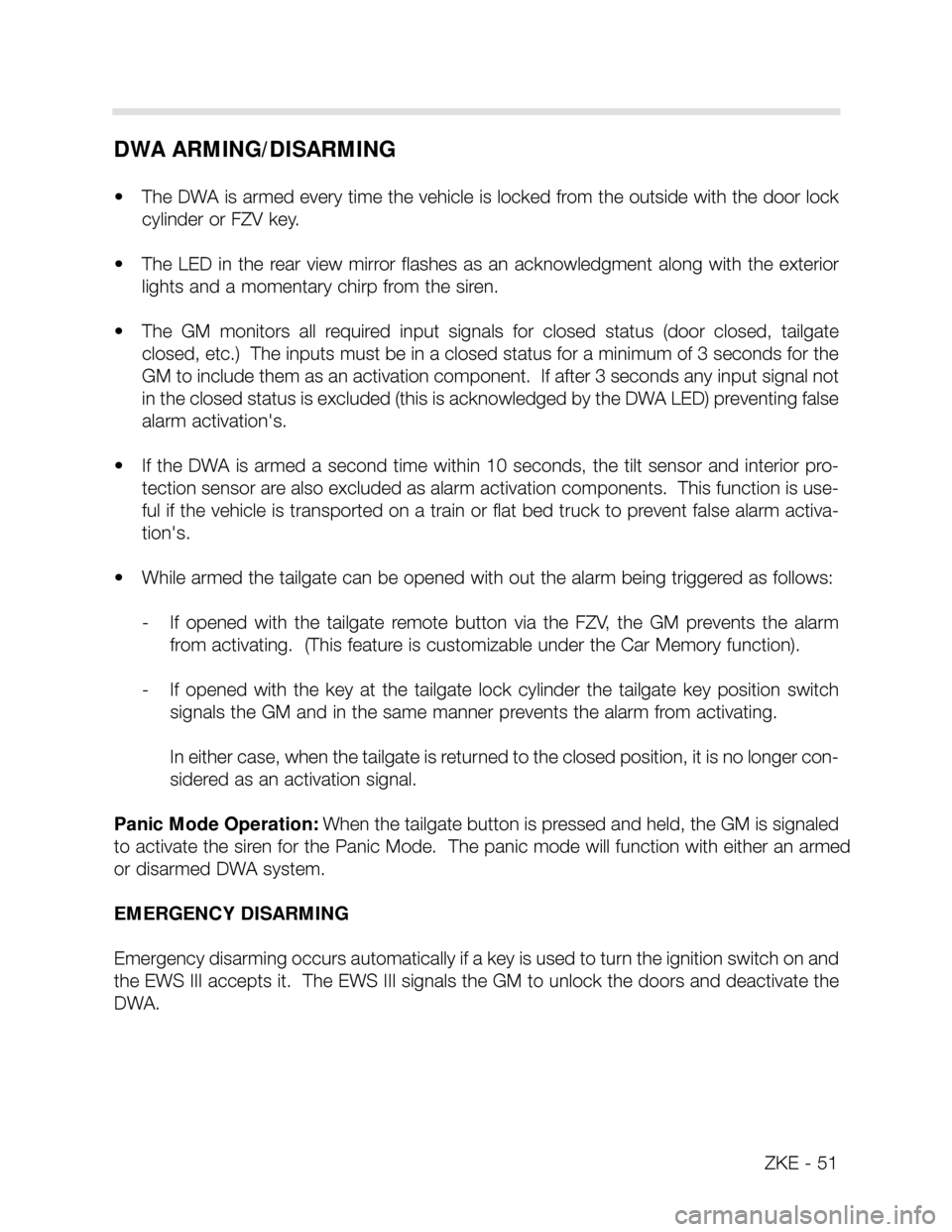
ZKE - 51
DWA ARMING/DISARMING
• The DWA is armed every time the vehicle is locked from the outside with the door lock
cylinder or FZV key.
• The LED in the rear view mirror flashes as an acknowledgment along with the exterior
lights and a momentary chirp from the siren.
• The GM monitors all required input signals for closed status (door closed, tailgate
closed, etc.) The inputs must be in a closed status for a minimum of 3 seconds for the
GM to include them as an activation component. If after 3 seconds any input signal not
in the closed status is excluded (this is acknowledged by the DWA LED) preventing false
alarm activation's.
• If the DWA is armed a second time within 10 seconds, the tilt sensor and interior pro-
tection sensor are also excluded as alarm activation components. This function is use-
ful if the vehicle is transported on a train or flat bed truck to prevent false alarm activa-
tion's.
• While armed the tailgate can be opened with out the alarm being triggered as follows:
- If opened with the tailgate remote button via the FZV, the GM prevents the alarm
from activating. (This feature is customizable under the Car Memory function).
- If opened with the key at the tailgate lock cylinder the tailgate key position switch
signals the GM and in the same manner prevents the alarm from activating.
In either case, when the tailgate is returned to the closed position, it is no longer con-
sidered as an activation signal.
Panic Mode Operation: When the tailgate button is pressed and held, the GM is signaled
to activate the siren for the Panic Mode. The panic mode will function with either an armed
or disarmed DWA system.
EMERGENCY DISARMING
Emergency disarming occurs automatically if a key is used to turn the ignition switch on and
the EWS III accepts it. The EWS III signals the GM to unlock the doors and deactivate the
DWA.
Page 52 of 64
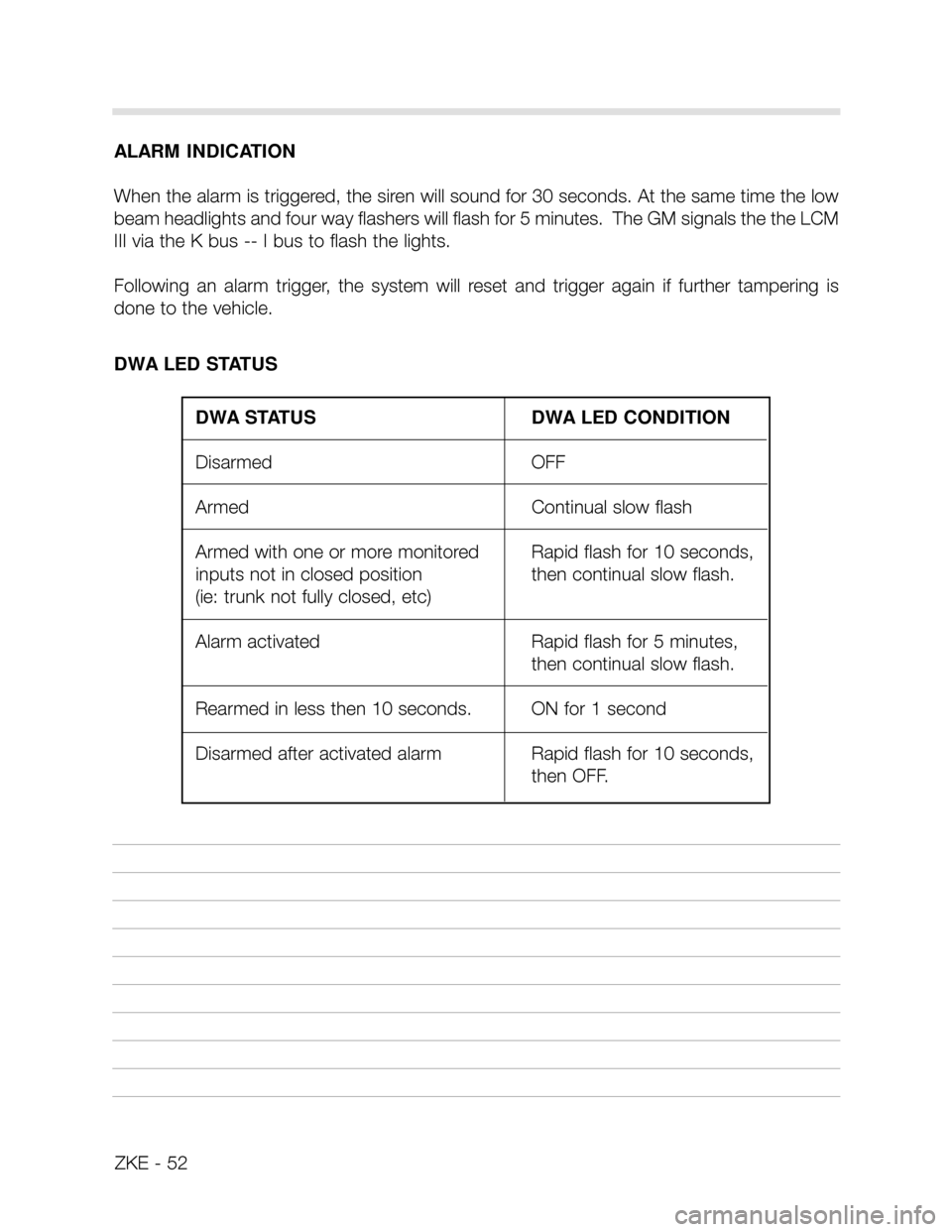
ZKE - 52
ALARM INDICATION
When the alarm is triggered, the siren will sound for 30 seconds. At the same time the low
beam headlights and four way flashers will flash for 5 minutes. The GM signals the the LCM
III via the K bus -- I bus to flash the lights.
Following an alarm trigger, the system will reset and trigger again if further tampering is
done to the vehicle.
DWA LED STATUS
DWA STATUS DWA LED CONDITION
Disarmed OFF
Armed Continual slow flash
Armed with one or more monitored Rapid flash for 10 seconds,
inputs not in closed position then continual slow flash.
(ie: trunk not fully closed, etc)
Alarm activated Rapid flash for 5 minutes,
then continual slow flash.
Rearmed in less then 10 seconds. ON for 1 second
Disarmed after activated alarm Rapid flash for 10 seconds,
then OFF.
Page 53 of 64
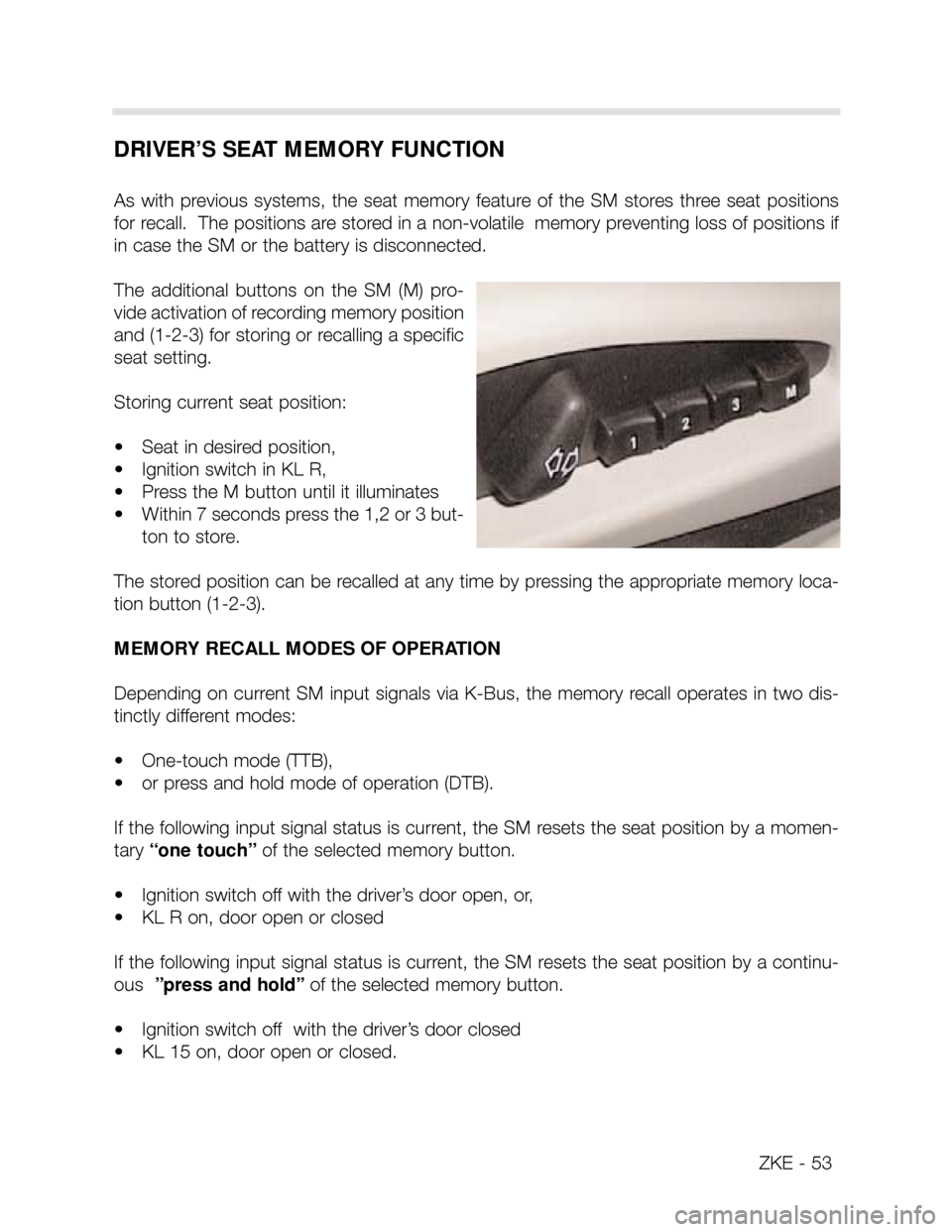
ZKE - 53
DRIVER’S SEAT MEMORY FUNCTION
As with previous systems, the seat memory feature of the SM stores three seat positions
for recall. The positions are stored in a non-volatile memory preventing loss of positions if
in case the SM or the battery is disconnected.
The additional buttons on the SM (M) pro-
vide activation of recording memory position
and (1-2-3) for storing or recalling a specific
seat setting.
Storing current seat position:
• Seat in desired position,
• Ignition switch in KL R,
• Press the M button until it illuminates
• Within 7 seconds press the 1,2 or 3 but-
ton to store.
The stored position can be recalled at any time by pressing the appropriate memory loca-
tion button (1-2-3).
MEMORY RECALL MODES OF OPERATION
Depending on current SM input signals via K-Bus, the memory recall operates in two dis-
tinctly different modes:
• One-touch mode (TTB),
• or press and hold mode of operation (DTB).
If the following input signal status is current, the SM resets the seat position by a momen-
tary“one touch”of the selected memory button.
• Ignition switch off with the driver’s door open, or,
• KL R on, door open or closed
If the following input signal status is current, the SM resets the seat position by a continu-
ous ”press and hold”of the selected memory button.
• Ignition switch off with the driver’s door closed
• KL 15 on, door open or closed.
Page 54 of 64
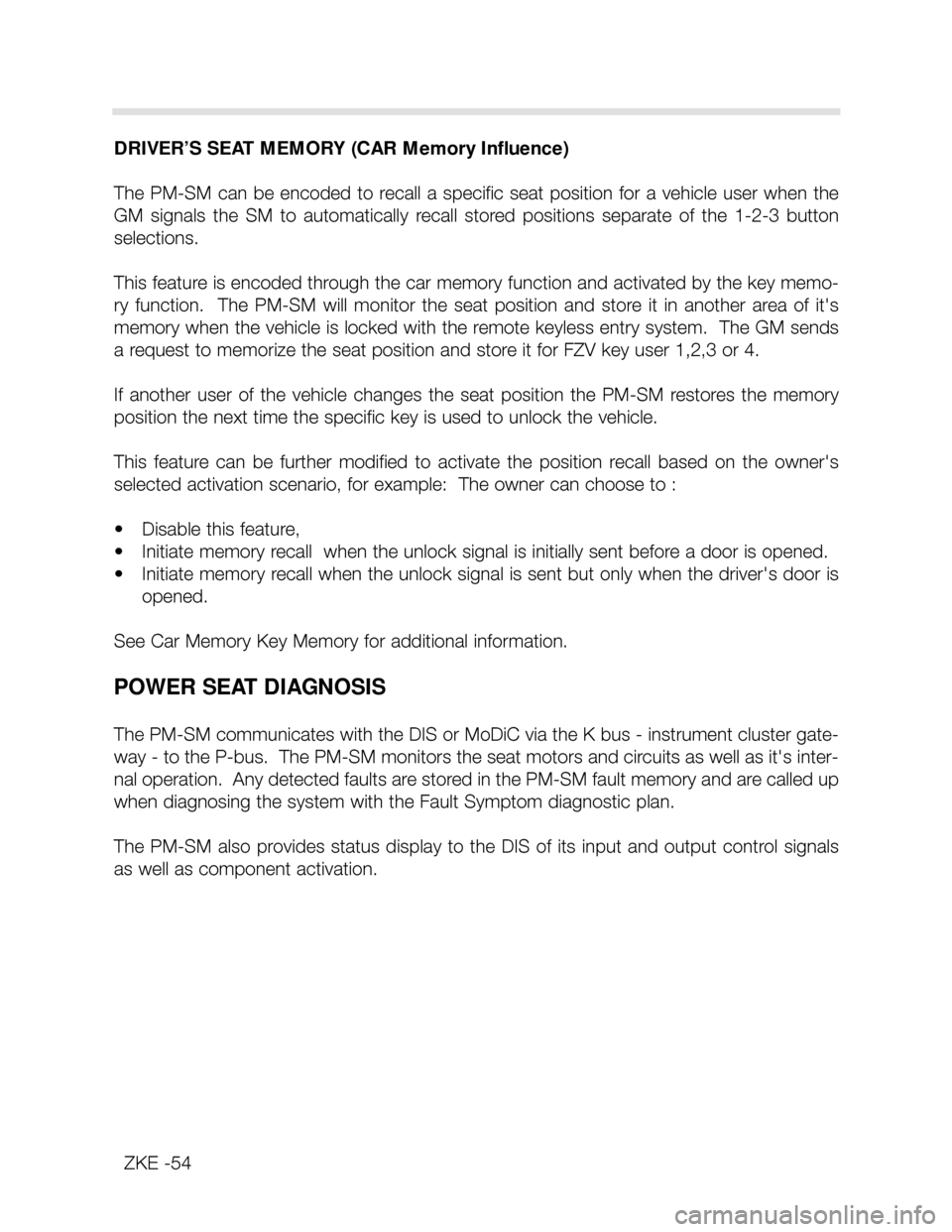
ZKE -54
DRIVER’S SEAT MEMORY (CAR Memory Influence)
The PM-SM can be encoded to recall a specific seat position for a vehicle user when the
GM signals the SM to automatically recall stored positions separate of the 1-2-3 button
selections.
This feature is encoded through the car memory function and activated by the key memo-
ry function. The PM-SM will monitor the seat position and store it in another area of it's
memory when the vehicle is locked with the remote keyless entry system. The GM sends
a request to memorize the seat position and store it for FZV key user 1,2,3 or 4.
If another user of the vehicle changes the seat position the PM-SM restores the memory
position the next time the specific key is used to unlock the vehicle.
This feature can be further modified to activate the position recall based on the owner's
selected activation scenario, for example: The owner can choose to :
• Disable this feature,
• Initiate memory recall when the unlock signal is initially sent before a door is opened.
• Initiate memory recall when the unlock signal is sent but only when the driver's door is
opened.
See Car Memory Key Memory for additional information.
POWER SEAT DIAGNOSIS
The PM-SM communicates with the DIS or MoDiC via the K bus - instrument cluster gate-
way - to the P-bus. The PM-SM monitors the seat motors and circuits as well as it's inter-
nal operation. Any detected faults are stored in the PM-SM fault memory and are called up
when diagnosing the system with the Fault Symptom diagnostic plan.
The PM-SM also provides status display to the DIS of its input and output control signals
as well as component activation.
Page 55 of 64
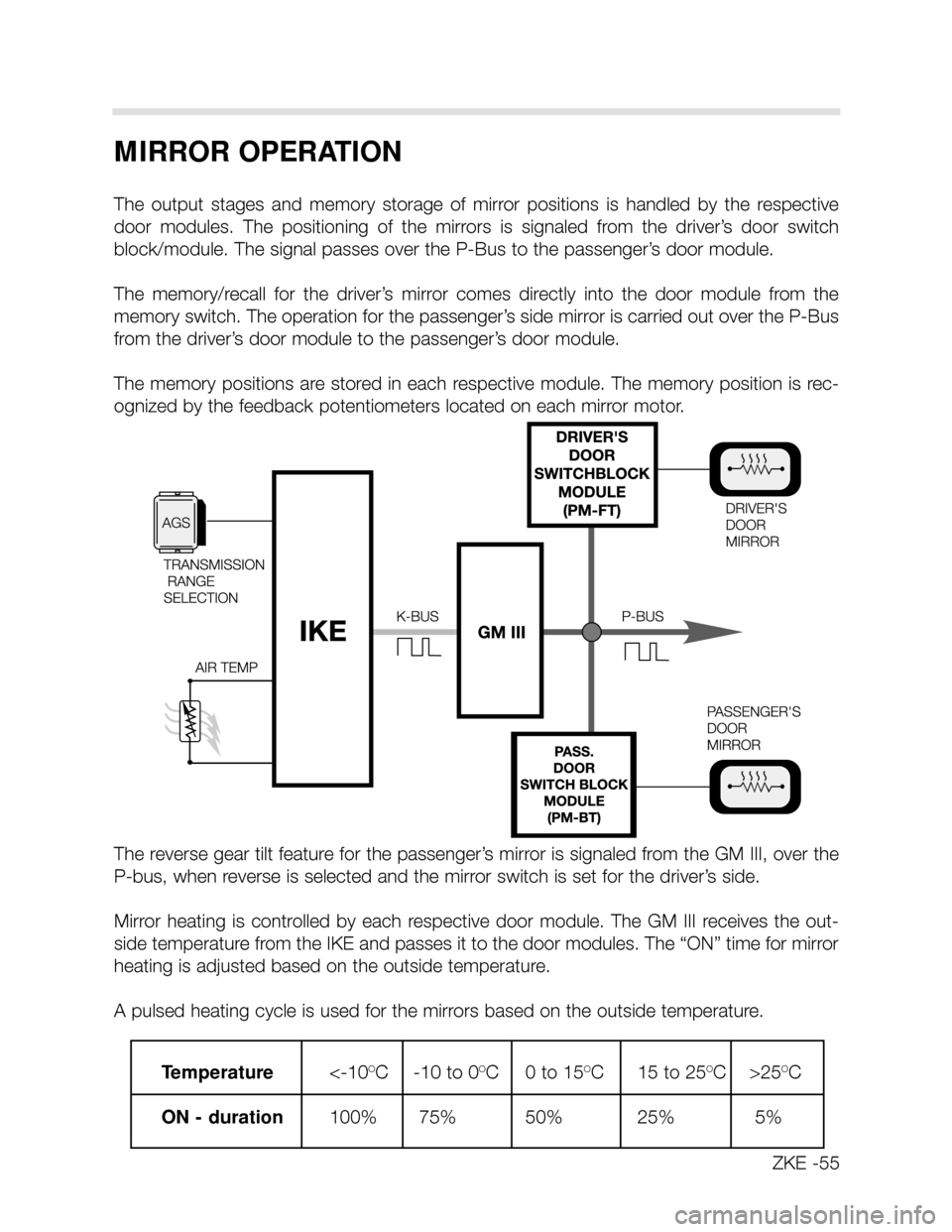
MIRROR OPERATION
The output stages and memory storage of mirror positions is handled by the respective
door modules. The positioning of the mirrors is signaled from the driver’s door switch
block/module. The signal passes over the P-Bus to the passenger’s door module.
The memory/recall for the driver’s mirror comes directly into the door module from the
memory switch. The operation for the passenger’s side mirror is carried out over the P-Bus
from the driver’s door module to the passenger’s door module.
The memory positions are stored in each respective module. The memory position is rec-
ognized by the feedback potentiometers located on each mirror motor.
The reverse gear tilt feature for the passenger’s mirror is signaled from the GM III, over the
P-bus, when reverse is selected and the mirror switch is set for the driver’s side.
Mirror heating is controlled by each respective door module. The GM III receives the out-
side temperature from the IKE and passes it to the door modules. The “ON” time for mirror
heating is adjusted based on the outside temperature.
A pulsed heating cycle is used for the mirrors based on the outside temperature.
ZKE -55
Temperature<-10OC -10 to 0OC 0 to 15OC 15 to 25OC >25OC
ON - duration 100% 75% 50% 25% 5%
Page 56 of 64
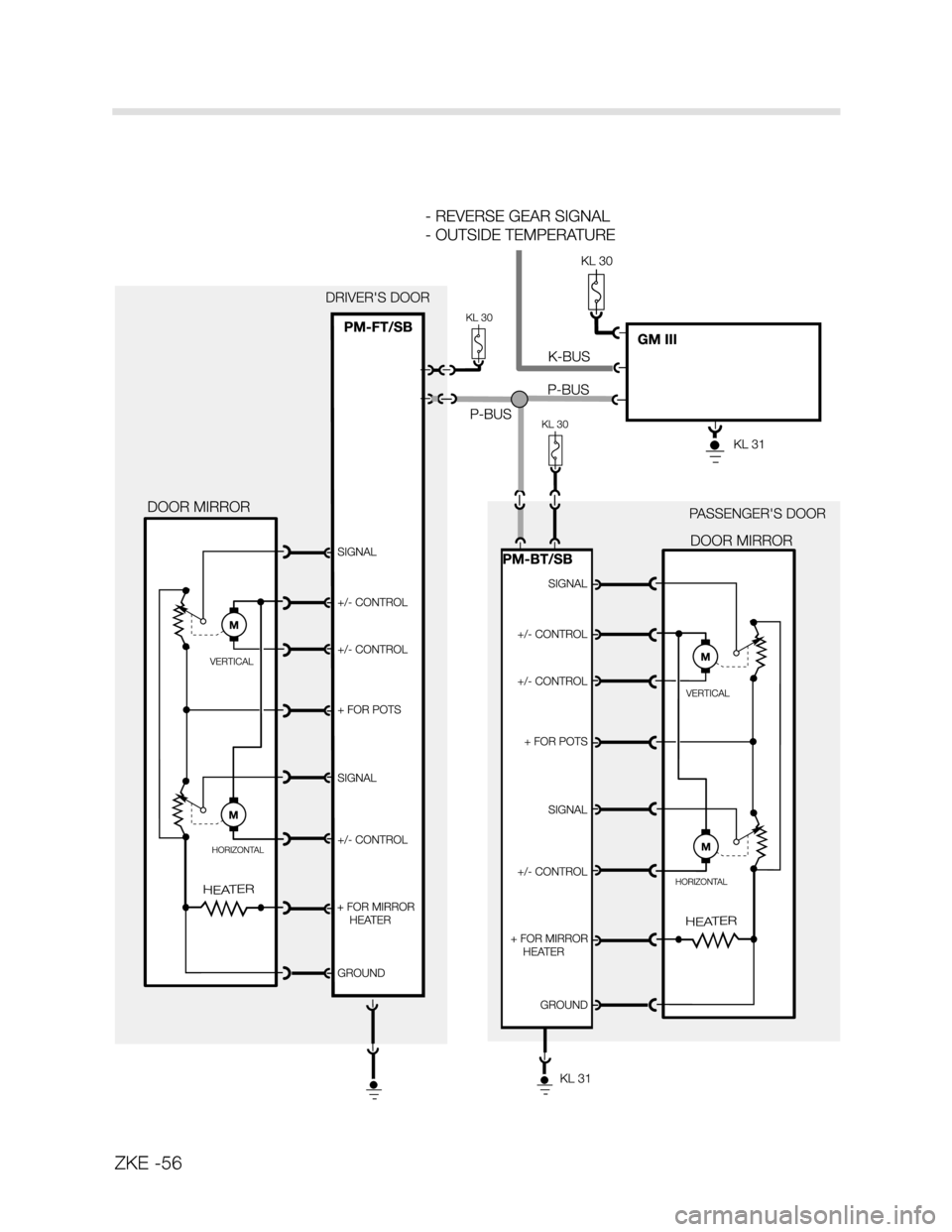
ZKE -56
Page 57 of 64
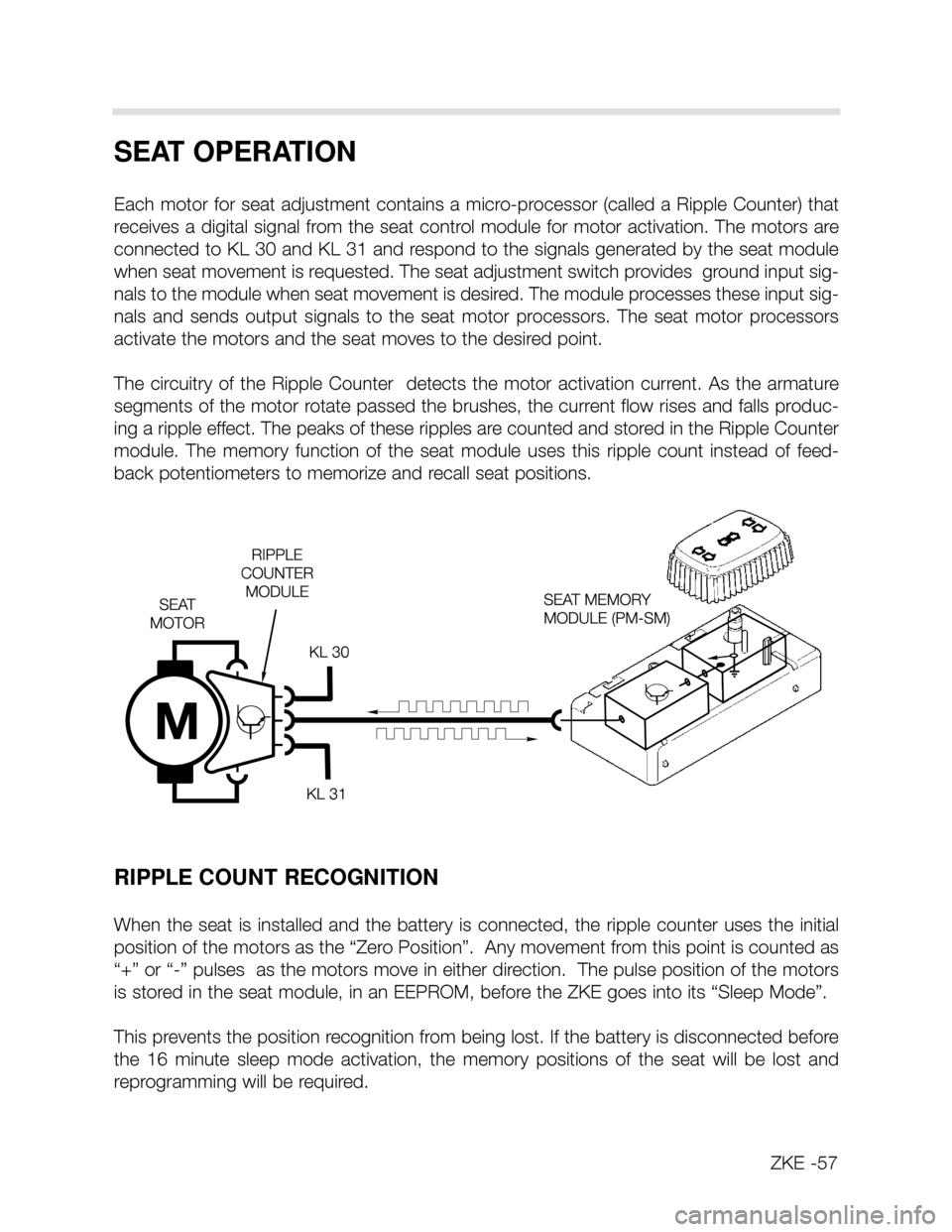
SEAT OPERATION
Each motor for seat adjustment contains a micro-processor (called a Ripple Counter) that
receives a digital signal from the seat control module for motor activation. The motors are
connected to KL 30 and KL 31 and respond to the signals generated by the seat module
when seat movement is requested. The seat adjustment switch provides ground input sig-
nals to the module when seat movement is desired. The module processes these input sig-
nals and sends output signals to the seat motor processors. The seat motor processors
activate the motors and the seat moves to the desired point.
The circuitry of the Ripple Counter detects the motor activation current. As the armature
segments of the motor rotate passed the brushes, the current flow rises and falls produc-
ing a ripple effect. The peaks of these ripples are counted and stored in the Ripple Counter
module. The memory function of the seat module uses this ripple count instead of feed-
back potentiometers to memorize and recall seat positions.
RIPPLE COUNT RECOGNITION
When the seat is installed and the battery is connected, the ripple counter uses the initial
position of the motors as the “Zero Position”. Any movement from this point is counted as
“+” or “-” pulses as the motors move in either direction. The pulse position of the motors
is stored in the seat module, in an EEPROM, before the ZKE goes into its “Sleep Mode”.
This prevents the position recognition from being lost. If the battery is disconnected before
the 16 minute sleep mode activation, the memory positions of the seat will be lost and
reprogramming will be required.
ZKE -57
Page 58 of 64
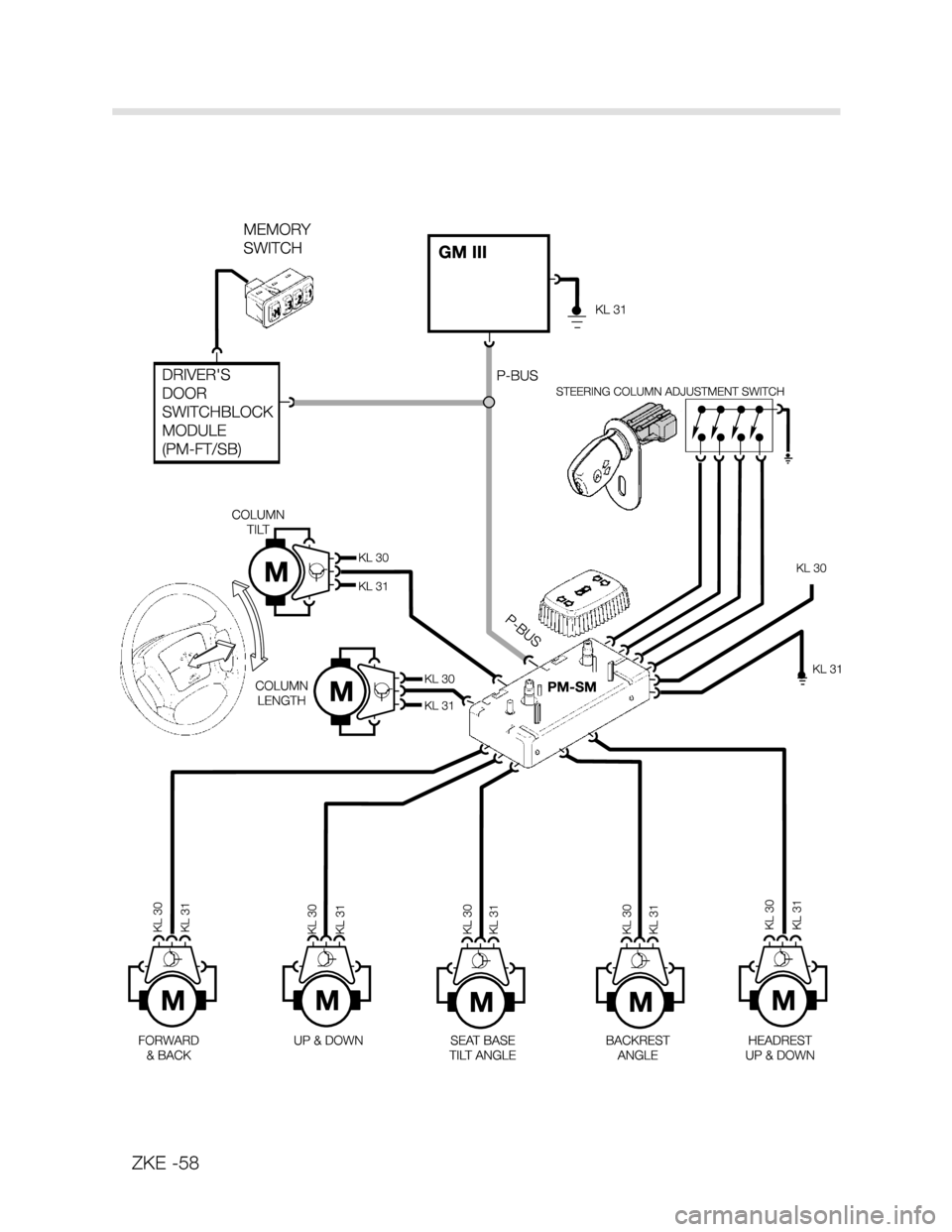
ZKE -58
Page 59 of 64
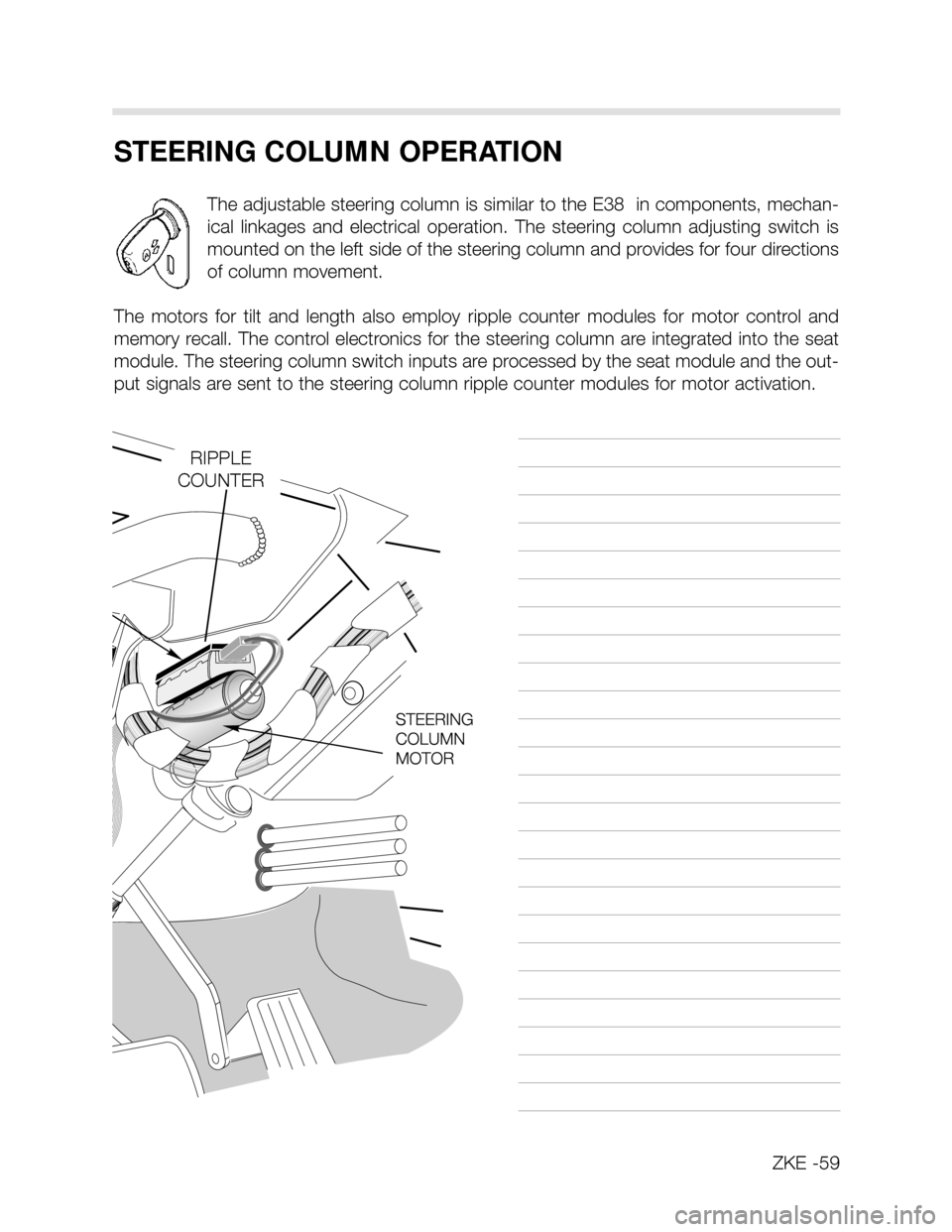
STEERING COLUMN OPERATION
The adjustable steering column is similar to the E38 in components, mechan-
ical linkages and electrical operation. The steering column adjusting switch is
mounted on the left side of the steering column and provides for four directions
of column movement.
The motors for tilt and length also employ ripple counter modules for motor control and
memory recall. The control electronics for the steering column are integrated into the seat
module. The steering column switch inputs are processed by the seat module and the out-
put signals are sent to the steering column ripple counter modules for motor activation.
ZKE -59
RIPPLE
COUNTER
Page 60 of 64
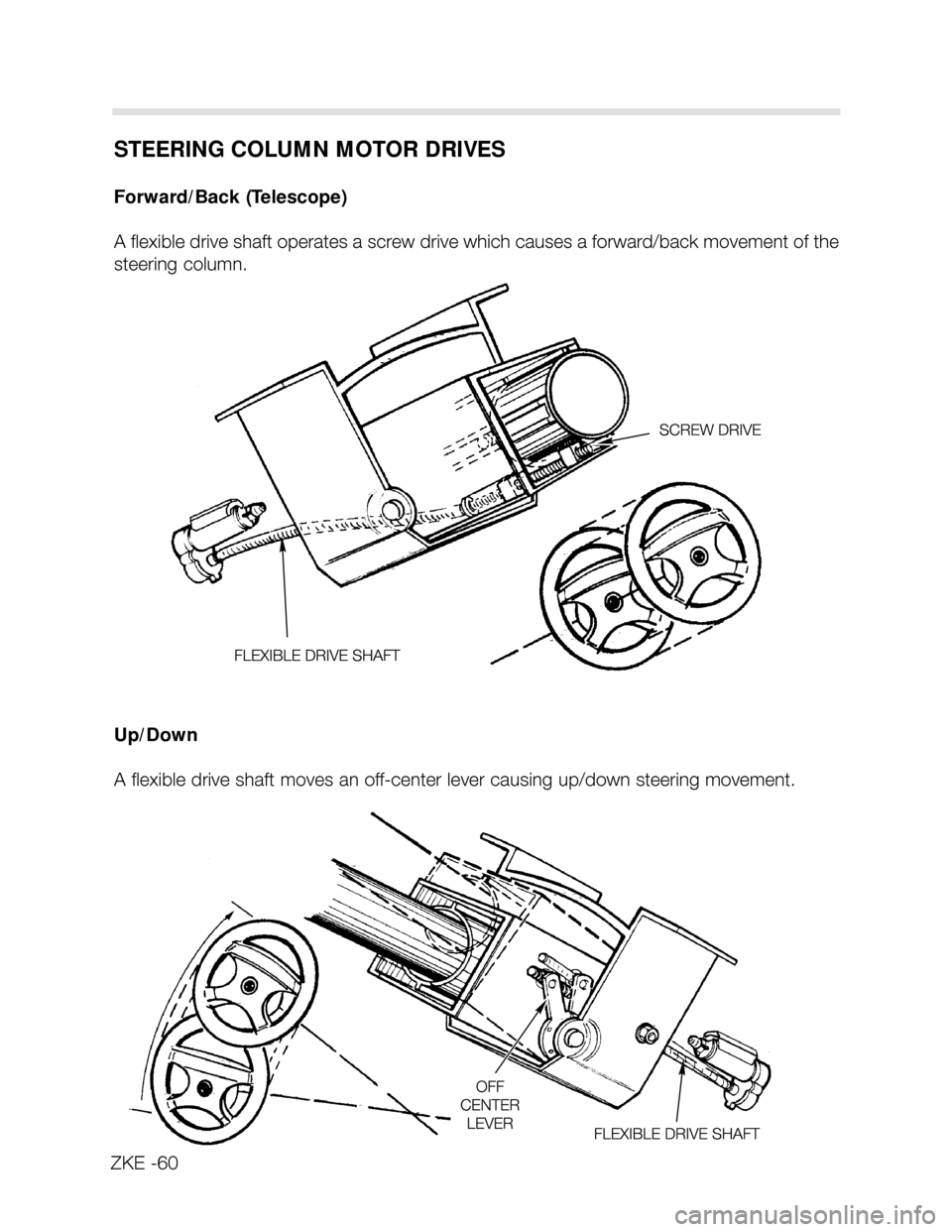
STEERING COLUMN MOTOR DRIVES
Forward/Back (Telescope)
A flexible drive shaft operates a screw drive which causes a forward/back movement of the
steering column.
Up/Down
A flexible drive shaft moves an off-center lever causing up/down steering movement.
ZKE -60